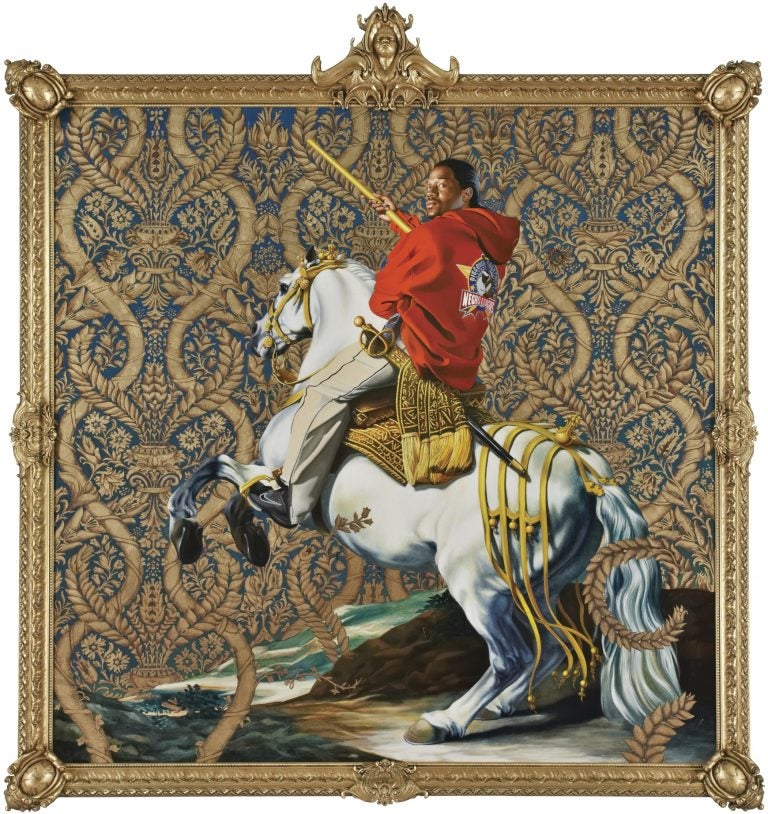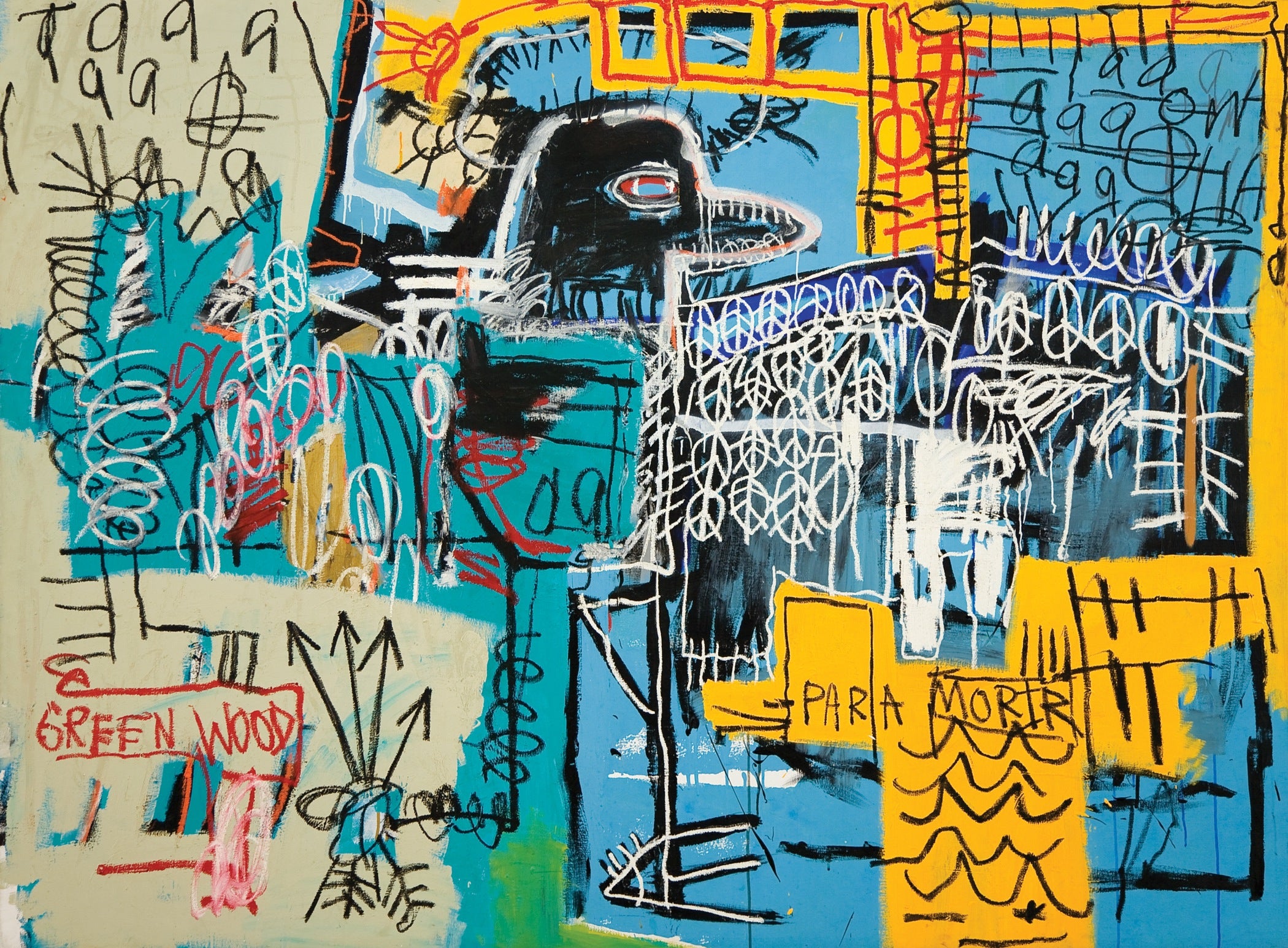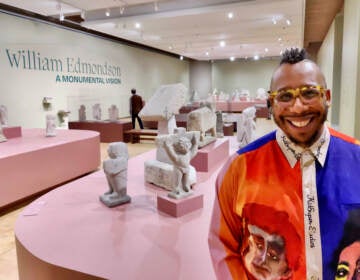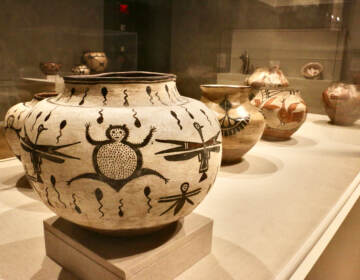‘30 Americans’ brings contemporary black art to the Barnes
The exhibit “30 Americans” — an ongoing, rotating show of high-profile black artists — has never before come to Philadelphia.
Listen 1:46
Artwork by Kehinde Wiley. (Courtesy of Rubell Family Collection, Miami)
To enter the Barnes Foundation gallery showing “30 Americans,” visitors must pass through a black steel gate hinged on a pair of brick columns, each topped with a small concrete sculpture of a Klu Klux Klansman. It’s a sculpture by the artist Gary Simmons.
Immediately inside, that visitor is confronted by a wall of cotton compressed into blocks — an artwork by Leonardo Drew.
Right at the outset, the show establishes its racial tone.
“It sets the stage for what comes after,” said curator Gwendolyn Dubois Shaw. “You have to be open to seeing things that are going to be disturbing. A lot of the work is not easy.”
Some of the work is easier than others. Kara Walker created a wall of black silhouette decal figures. “Camptown Ladies” depicts scenes of historic slavery in all their violence and fear.
On the other hand, Kerry James Marshall’s “Vignette #10” is a loosely painted, monochrome scene of two people embracing, emitting pink hearts.
“It’s black love. It’s black joy. It’s something that I think is hard for some people to imagine being celebrated,” Shaw said. “If we think about African American issues, we don’t usually think of love being one of those issues.”
“30 Americans” is a show of work by 30 African American artists. The approximately 60 works all come from the Rubell Family Collection in Miami, a vast collection of contemporary art that started in the 1980s and continues to grow.
Ten years ago, the Rubell family selected 30 African American artists represented in its collection, to highlight as a touring show. “30 Americans” has been through 17 iterations as it bounced in and out of various museums across the country, each one different from the last.
Though the artists on the roster don’t change — including heavy hitters like Jean-Michel Basquiat, Kehinde Wiley, Carrie Mae Weems, and Barkley Hendricks — the works selected to represent them do.
Shaw was hired by the Barnes Foundation to work with the Rubell collection and assemble the first “30 Americans” show in Philadelphia.
“A lot of the work in the exhibition focuses on issues of black identity and the African American experience, but really that is the American experience,” said Shaw, a professor at the University of Pennsylvania. “It’s about the American identity and about modern identity.”
Case in point are five works by Hank Willis Thomas, all coming from a series in which he pulled advertising images from magazines of the 1970s and ’80s featuring African American figures, then stripped away all the copy’s text.
The images, adrift from the context of selling products, reveal bizarre scenarios that would never happen in life: a black man grinning over a loose meat sandwich is glared at by his white neighbor; a black family dressed in African clothes stands on one side of an SUV while a black man dressed as Santa Claus is on the other side.
The images speak to an African American experience, but also to a collective American experience of living in a warped world of advertising.
One of the popular draws of the show likely will be the two works by Basquiat — a painting and an assemblage — made with his street-art aesthetic. Since his death in 1988 at age 27, Basquiat has become one of the most sought-after artists in the world. The auction price for his work ($110 million) has set the record for any American artist.

The Rubell family acquired the Basquiats while the artist was still alive. They only buy work from living artists, usually right out of the studio. The Rubell family never buys at auction, according to Shaw.
Another attraction is a large-scale Kehinde Wiley painting that draws from a 17th-century portrait by Diego Velázquez. Wiley uses the classic format but paints the figure on the horse as a young black man in Nikes and a hoodie, against a backdrop of an African textile pattern.
It comes from a highly regarded series of paintings by Wiley in which he paints black bodies into Western art history. Later, Wiley would paint the official portrait of President Barack Obama.
Shaw said the “30 Americans” show, as it has bounced around the country for a decade, has changed the museums in which it lands.
“Many of those museums have purchased works by those artists in the show,” she said. “That is due to the great success of the show wherever it has gone. It has broken attendance records at a lot of museums it has been featured at.”
“30 Americans” opens Sunday at the Barnes Foundation, where it will remain until Jan. 12, 2020.
WHYY is your source for fact-based, in-depth journalism and information. As a nonprofit organization, we rely on financial support from readers like you. Please give today.





